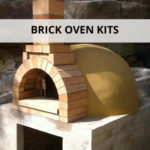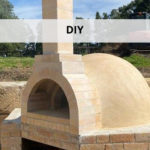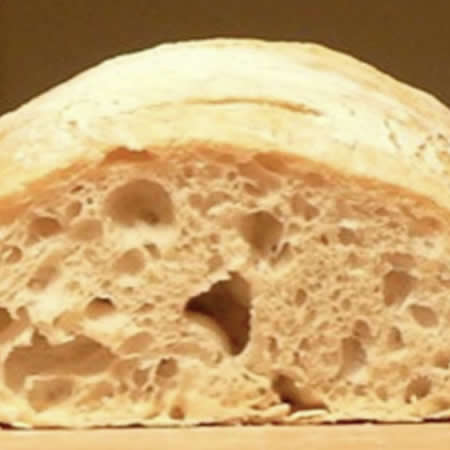CHOCOLATE AND STRAWBERRY PIZZA
Chocolate and Strawberry Pizza is the perfect end to a pizza dinner!
INGREDIENTS
- Your preferred pizza dough
- 225g chocolate bar, semi-bitter is best, grated
- 250-450g strawberries, cleaned and chopped
PREPARATION
- Fire your oven until it reaches pizza heat• Shape your pizza dough as usual (try a rolling pin)
- Sprinkle grated chocolate all over the shaped dough and then add the strawberries.
- Cook until the pizza rim is browned and the chocolate melted – about 2 minutes
Options: Blend the chocolate with 2 tablespoons of milk or cream for a milder taste or 2 tablespoons of condensed milk to make a sweeter, heavier topping.
NO-KNEAD BREAD
The notion of baking bread without any kneading is not new, but the method received a lot of attention when it appeared in The New York Times on November 8, 2006. The formula given here is an adaptation of Jim Lahey’s version as it was given there. This bread is so simple to make, you will hardly believe it at first. It should be stressed from the outset that to get a good, open crumb in this type of bread, quick, gentle handling is a must.
The classic open-whole structure seen in this No-Knead Bread results from gentle handling, high hydration in the dough and high-temperature baking.
INGREDIENTS AND PREPARING THE DOUGH
- 425g flour (either half bread flour and half all-purpose, or all-purpose only, plus more for
dusting)
- ¼ tsp. instant dry yeast (IDY)
- 2 tsp. sea salt
- 360ml filtered, bottled (no salt added) or spring water
While you are weighing your flour, add in a few tablespoons of whole wheat flour and a few tablespoons of wheat germ before you reach your target weight with the other flours. Don’t exceed 425g in total. Make it once, and you may want to experiment with other flour combinations, including up to 30% whole grain or whole wheat, or 10% rye.
In a large bowl, stir together the flour and the yeast. Add the water and stir until the dough begins to come together. Add the salt and continue stirring until blended. The dough will be very sticky.
Using a plastic dough scraper dipped in cool water, transfer the dough into another large bowl that has been misted with spray oil. Cover this bowl tightly with plastic wrap. Let the dough ferment, at warm room temperature (21ºC), for at least 12 hours and as much as 18.
FORMING
The dough is ready to go when the surface shows a consistent pattern of bubbles.
Using a plastic dough scraper dipped in cool water, very gently turn the dough out of the bowl onto a well floured work surface. (You can get an even layer on the surface by sprinkling the flour from a fine sieve). Sprinkle the top of the dough with a little more flour. Gently place your floured left hand in the middle of the dough, then pull the end of the dough toward you a few inches with your right hand. Fold that portion to the center of the dough (where your hand was). Repeat with the other end of the dough, and then fold the dough into a rectangle, like a letter. Loosely cover the dough with plastic wrap and let rest for about 20 minutes.
While the dough is resting, turn a sheet pan upside down. Cut a piece of parchment paper to fit the flat side (or use a non-stick mat if you have one). Mist the parchment paper with spray oil. Now quickly and gently shape the dough into an approximate ball (shaping is not too important in this recipe; close will do). Sprinkle the sprayed parchment paper with flour, and then flour your hands. Very gently place the dough, seam side down, on the parchment paper. Mist the surface of the dough with spray oil, dust with flour, and cover completely but loosely with plastic wrap. Let it rise for about three hours in a warm, draft free area, or until more than doubles in size. It should not spring back quickly when you poke it with your finger.
BAKING
A half hour, roughly, before the dough is ready, put a six quart, heavy, cast iron pot with the lid in place on the floor of your oven. The floor temperature should be 290º C. The pot can be round or oval, and the shape and size will affect the shape of the finished loaves (experiment here when you’ve made it once). A four quart pot, either round or oval, will result in a taller loaf.
Once the dough is ready, use oven mitts to take the pot out of the oven. Remove the lid. Slide the parchment paper off the pan onto your right hand and turn the dough, seam side up, into the pot. If the dough looks at all lumpy, give the pot a shake to even it out.
Cover with the lid and bake for 30 minutes. Remove the lid and bake another 15 minutes or so until the bread is well browned. The internal temperature should be 96ºC. Turn the bread out of the pot and cool completely on a wire rack.
HINTS
There is no need to inject steam into your oven for this bread, because the covered pot traps the steam from the very wet dough.
Try stirring in chopped fresh herbs once the flour is hydrated in the bowl: chives, parsley, basil or oregano would make it go nicely with soft cheeses, such as Brie.
As it rises, the bread will take on the shape of the pot you use.







